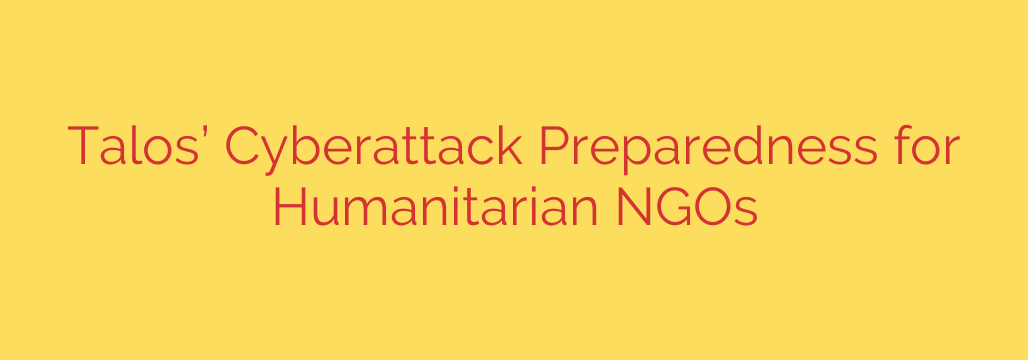
Cybersecurity for Non-Profits: A Guide to Protecting Your Mission
Humanitarian and non-governmental organizations (NGOs) work on the front lines of the world’s most complex challenges. From providing aid in conflict zones to protecting vulnerable populations, your mission is critical. Unfortunately, this vital work also makes you a prime target for sophisticated cyberattacks.
Protecting your organization is not just about securing data; it’s about protecting the people you serve, the integrity of your operations, and the trust you’ve built. This guide outlines why NGOs are targeted and provides actionable steps to build a resilient cyber defense.
Why Hackers Are Targeting Humanitarian Organizations
It’s a misconception that cybercriminals only target large, for-profit corporations. In reality, NGOs are highly attractive targets for several reasons:
- Possession of Sensitive Data: NGOs often hold a wealth of highly sensitive information. This can include personal data of refugees, political dissidents, aid recipients, and activists. For malicious actors, this information is a goldmine for espionage, blackmail, or disruption.
- Operating in Geopolitical Hotspots: Your work often places you in the middle of politically charged environments. This makes you a target for nation-state actors seeking to monitor, disrupt, or gather intelligence on activities within a specific region.
- Perceived as “Soft Targets”: Attackers assume that non-profits have limited budgets, overworked IT staff, and less mature security infrastructure compared to commercial enterprises. They bet on finding unpatched systems and undertrained staff, making you an easier target.
The attackers range from nation-states conducting espionage to financially motivated criminals looking for a quick payout through ransomware. Regardless of the motive, the impact of an attack can be devastating.
The Top Cyber Threats Facing NGOs Today
Understanding the specific methods attackers use is the first step toward building a strong defense. The most common threats include:
- Phishing and Spear-Phishing: These are deceptive emails designed to trick your staff into revealing login credentials or downloading malicious software. Spear-phishing is a more targeted version where attackers use information specific to your organization or an employee to make the email seem more legitimate.
- Ransomware: This type of malware encrypts your files, making them inaccessible until you pay a ransom. For an NGO, a ransomware attack can halt operations completely, cutting off aid and communication when it’s needed most.
- Denial-of-Service (DDoS) Attacks: These attacks flood your website and network with traffic, overwhelming your systems and knocking them offline. A DDoS attack can prevent donors from contributing, volunteers from signing up, and people in need from accessing critical information.
Actionable Steps to Build a Resilient Defense
Limited resources do not mean you have to be defenseless. Focusing on foundational, high-impact security measures can dramatically reduce your risk.
1. Implement Multi-Factor Authentication (MFA)
If you do only one thing, do this. Multi-Factor Authentication (MFA) is arguably the single most effective security measure you can implement. It requires a second form of verification (like a code from a phone app) in addition to a password. Even if an attacker steals a password, MFA prevents them from gaining access to the account. Enable it on all critical platforms, starting with email, financial systems, and donor databases.
2. Develop a Proactive Patching Strategy
Software vulnerabilities are a primary entry point for attackers. Regularly updating your software, operating systems, and applications is crucial. Create a simple schedule to check for and apply security patches. Prioritize systems that are exposed to the internet, such as your website and email servers.
3. Train Your People: The Human Firewall
Your employees and volunteers are your first line of defense, but they can also be your weakest link. Invest in regular security awareness training. Teach them how to spot phishing emails, use strong and unique passwords, and report suspicious activity immediately. A well-informed team is an invaluable security asset.
4. Create an Incident Response (IR) Plan
It’s not a matter of if you will face a cyber incident, but when. An Incident Response plan is a documented guide that outlines exactly what to do when an attack occurs. It should answer key questions:
- Who is on the response team?
- How do we contain the threat?
- Who do we need to notify (legal, law enforcement, stakeholders)?
- How do we recover our systems and data?
Having a plan ready means you can respond quickly and effectively, minimizing damage and downtime.
5. Secure Your Data with Encryption and Access Control
Ensure that sensitive data is protected both when it is stored (at rest) and when it is being transmitted (in transit). Use encryption for laptops, servers, and backups. Furthermore, implement the principle of least privilege, meaning that employees should only have access to the data and systems absolutely necessary for their jobs.
From Reactive to Proactive: A Security Mindset
Ultimately, cybersecurity for an NGO is about shifting from a reactive posture to a proactive one. Don’t wait for an attack to prove you need better defenses. By implementing these foundational security controls, you are not just protecting your organization—you are safeguarding your mission. Every step you take to strengthen your cyber defense ensures you can continue your vital work securely and without disruption.
Source: https://blog.talosintelligence.com/backdoors-breaches-how-talos-is-helping-humanitarian-aid-ngos-prepare-for-cyber-attacks/








